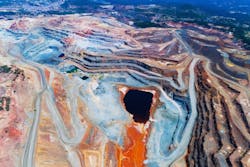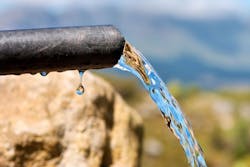Mitigating Mining Water Loss
Arjan Boogaards is senior vice president of global mining for Nalco Water. Boogaards can be reached at [email protected].
With a growing, more prosperous population, the world needs more things. Things are made of basic materials, and many of those materials are mined. However, the world also needs more water, a finite commodity, which is becoming scarcer, because it, too, is needed to provide food, sanitation, goods and services for a larger and richer world population.
That is why industries around the world are learning to do more with less water, and mining is no exception. Fortunately, the technology is available to extract basic materials while cutting down on water use and protecting the environment, all while operating in an economically viable way.
Competing Demands
Water has a host of applications in mining, including mineral processing, material handling and tailings management. Increasingly, with the growing demand for mineral resources and exhaustion of more easily accessible reserves, much of today’s mining activity takes place in inhospitable regions near communities and environmentally sensitive water sources. That is just one of many demands that make sustainable water management a more urgent and more challenging proposition for mining companies.
Water scarcity is becoming the new normal around the world. Already, two billion people live in water-stressed regions, and that number is expected to rise. If global society keeps using water at the same rate, the world will see a 40% freshwater shortfall by 2030, according to United Nations projects. That reality demands increasing attention to water—and how to use less of it—from every industry, including one as fundamental as mining.
Meanwhile, regulators pressure mining companies to improve sustainable operations and mitigate environmental risk. In the age of social media and increased access to mass communications for all, communities are more vocal about their gripes with neighboring industries. By its very nature, the mining sector is a large, inviting target.
Increasingly, investors, too, are showing concerns about sustainability. For now, profitability is generally top-of-mind, but a mine that sees its license to operate threatened by sustainability concerns is not a profitable enterprise in the long run. Subsequently, environmental stewardship, public health and social equity are gaining importance in long-term governance for mining operations.
Water plays a key role in all these instances. When there is less of it to go around, all users must rethink how they manage their water resources. Pollution issues can lead to clashes with regulators and communities. Besides the potential of stalled operations and lost revenue, the potential reputation damage and tarnished brands that come with water issues may cause investors to think twice about allocating their resources to the mining industry.
Unsurprisingly, the International Council on Mining and Metals warns, “Water is one of the most significant issues facing the mining and metals industry and is a critical resource not only for all our members’ operations but also for other industries, communities and the natural environment.”
Helping Mines Manage Water
Naperville, Illinois-based Nalco Water, an Ecolab company, works with hundreds of mining and minerals processing customers around the world to improve water management, reduce costs and lower risks associated with water. For more than 50 years, the company has served mining companies around the world in all segments of the industry.
The company delivers its mining solutions through a combination of holistic site audits that identify and remedy challenges and breakdowns along the production process, a broad line of technologies that improve efficiency, sustainability and profitability and customized, on-site service by experienced engineers.
That model bore fruit at a copper mine in northern Chile, where improved water management delivered a $12 million profitability increase while decreasing freshwater usage by 1 million cubic meters or 264 million gallons.
Chile, which essentially is a 2,700-mile ribbon of land between the Andes mountains and the Pacific Ocean, is increasingly water-stressed. Traditionally dependent on glacier meltwater from the Andes, the country’s vulnerability to water scarcity is accelerating as snow-packs and glaciers in the high mountains recede due to climate change.
But Chile also is one of the world’s largest copper mining countries—an industry that requires significant amounts of water. At one specific copper mine, approximately 2.5 cubic meters (660.5 gallons) of water is required to produce 1 ton of ore. This meant it had to recirculate 300,000 cubic meters (87 million gallons) of water per day. However, changes in water management led to increased levels of suspended solids in the process water, which in turn caused scale formations that blocked the pipes.
With critical parts of the process threatening to clog up, mine management turned to Nalco Water, which conducted a full plant audit and fed the resulting data into its Mining Optimizer software, which models how water, solids and processing chemistries interact inside water systems.
Nalco Water found that, even though the correct anti-scalant was used, the water mix was ineffective. It addressed the problem by adding or altering dosage points at strategic locations throughout the process to ensure a better water mix throughout the system. These actions were completed with live digital monitoring to keep tabs on changes in the system water and enable corrective changes in real-time, along with a new service plan to manage the changes over the longer term.
As a result, the mine upped its ability to keep scale formation in check, leading to nearly $4 million in reduced maintenance cost and a 3,000-ton growth in annual copper production. This resulted in $8.5 million in added annual revenue. The 1 million cubic meters of water saved in the process is equivalent to the annual drinking water needs of 913,000 people.
Reducing Environmental Impacts
Water scarcity is a function of water quantity and quality. You may find yourself surrounded by water, but if that water is not good enough to use or consume, your predicament is effectively identical to having no water available. For example, think of a shipwreck survivor caught out on the open ocean in a lifeboat.
This is why, for industries that use water, water quality is not just a matter of regulatory compliance. It also is part of their overall water stewardship approach: ensuring sufficient, quality water for the surrounding communities, other industrial facilities, agriculture and the natural environment.
That was the case for an open-pit copper mine in Spain, where heavy rainfall created high flows of wastewater that required constant management. The mine had already had its share of run-ins with the community over water quality concerns prior to the start of its relationship with Nalco Water a decade ago. It was specifically interested in controlling heavy metals and other contaminants in its water flows to maximize water efficiency, minimize discharge water and be maximally self-sufficient for its water needs.
After a thorough site audit, the Nalco Water team developed an action plan with a range of process optimizations and technologies. The plan included placing a full-time Nalco Water expert on-site to assist the company with monitoring and water management protocols, and a mind-set change from seeing the ponds where raw process water is gathered as regulation and equalization elements instead of just holding reservoirs. With these more effective treatments, the mine was able to remove larger amounts of solid contaminants at critical stages of the process.
Furthermore, sand filters were introduced to protect the site’s ultrafiltration systems from severe fouling. More efficient membranes were installed to reduce energy consumption. Flexible monitoring protocols were adopted to account for seasonal variations, such as increasing analysis frequency in rainy periods and adding treatment programs to protect membranes in dryer seasons.
This holistic approach reduced the mine‘s water discharge by 40%, lowered its energy usage by 22%, extended its filtration membranes’ life spans by two years and saved more than 1.1 million euros ($1.23 million USD) annually.
On top of these efficiency gains and cost savings, the mine has reduced its environmental impact and lowered its regulatory risk, which will allow it to exist in harmony with the surrounding community and safeguard its license to operate as it continues to supply society’s basic materials, even in a more water-scarce world.

